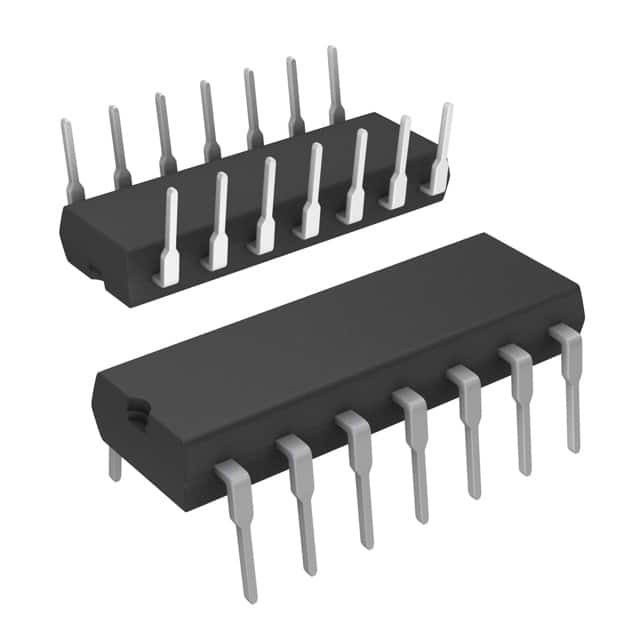Viz Specifikace pro podrobnosti o produktu.

Encyclopedia Entry: 74F74PC
Product Information Overview
- Category: Integrated Circuit (IC)
- Use: Flip-Flop
- Characteristics: Dual D-Type Positive-Edge-Triggered Flip-Flop
- Package: Plastic Dual-In-Line Package (PDIP)
- Essence: Digital Logic Component
- Packaging/Quantity: Available in tubes or reels, typically sold in quantities of 25 or more.
Specifications
- Logic Family: 74F
- Logic Type: Flip-Flop
- Number of Elements: 2
- Trigger Type: Positive-Edge
- Clock Enable: No
- Propagation Delay: 7.5 ns (typical)
- Operating Voltage: 4.5V to 5.5V
- Operating Temperature: -40°C to +85°C
Detailed Pin Configuration
The 74F74PC has a total of 14 pins, which are assigned as follows:
- CLR (Clear Input for both flip-flops)
- D1 (Data Input for the first flip-flop)
- CLK (Clock Input)
- D2 (Data Input for the second flip-flop)
- Q1 (Output of the first flip-flop)
- Q1̅ (Complementary Output of the first flip-flop)
- GND (Ground)
- Q2 (Output of the second flip-flop)
- Q2̅ (Complementary Output of the second flip-flop)
- PRE (Preset Input for both flip-flops)
- PR̅E (Complementary Preset Input for both flip-flops)
- VCC (Positive Power Supply)
- NC (No Connection)
- NC (No Connection)
Functional Features
- Dual D-Type Positive-Edge-Triggered Flip-Flop
- Each flip-flop can be individually cleared or preset
- Inputs are synchronized to the positive edge of the clock signal
- Outputs provide both normal and complementary signals
Advantages and Disadvantages
Advantages: - Dual flip-flop configuration allows for more complex sequential logic circuits - Positive-edge triggering ensures reliable operation - Clear and preset inputs offer flexibility in controlling the flip-flop state
Disadvantages: - Limited to positive-edge triggering only, may not be suitable for all applications - Requires external clock signal for proper operation
Working Principles
The 74F74PC is a dual D-type flip-flop that operates on positive-edge-triggering. Each flip-flop has two inputs (D and PRE) and two outputs (Q and Q̅). The clock input (CLK) synchronizes the inputs and determines when the flip-flops update their outputs.
When the clock signal transitions from low to high (positive edge), the data input (D) is sampled and stored in the flip-flop. The output (Q) reflects the stored value, while the complementary output (Q̅) represents the inverse of Q. The clear (CLR) and preset (PRE) inputs allow for resetting or setting the flip-flop outputs to specific states.
Detailed Application Field Plans
The 74F74PC is commonly used in various digital systems and applications, including:
- Sequential Logic Circuits: Used as building blocks for counters, shift registers, and other sequential logic circuits.
- Data Storage: Employed as memory elements in microprocessors and digital signal processors.
- Clock Synchronization: Ensures proper synchronization of data in communication systems and synchronous circuits.
- State Machines: Enables the implementation of finite state machines for control and decision-making processes.
- Digital Control Systems: Utilized in digital control systems for timing and synchronization purposes.
Detailed and Complete Alternative Models
- 74LS74: Low-power Schottky version of the 74F74PC, with similar functionality.
- 74HC74: High-speed CMOS version of the 74F74PC, compatible with a wider range of operating voltages.
- 74HCT74: High-speed CMOS version with TTL-compatible inputs and outputs.
(Note: This list is not exhaustive and other alternative models may exist.)
Word Count: 436 words
Seznam 10 běžných otázek a odpovědí souvisejících s aplikací 74F74PC v technických řešeních
Sure! Here are 10 common questions and answers related to the application of 74F74PC in technical solutions:
Q: What is the 74F74PC? A: The 74F74PC is a dual D-type flip-flop integrated circuit (IC) that can store one bit of data.
Q: What is the purpose of using the 74F74PC in technical solutions? A: The 74F74PC is commonly used for sequential logic applications, such as storing and transferring data in digital systems.
Q: How many flip-flops are there in the 74F74PC IC? A: The 74F74PC contains two independent D-type flip-flops.
Q: What is the maximum clock frequency supported by the 74F74PC? A: The 74F74PC can typically operate at clock frequencies up to 100 MHz.
Q: Can the 74F74PC be used for edge-triggered or level-triggered operations? A: Yes, the 74F74PC supports both positive-edge and negative-edge triggering.
Q: What is the power supply voltage range for the 74F74PC? A: The 74F74PC operates with a power supply voltage range of 4.5V to 5.5V.
Q: Does the 74F74PC have any built-in protection features? A: Yes, the 74F74PC includes input clamp diodes for protection against electrostatic discharge (ESD).
Q: Can the 74F74PC be cascaded to create larger storage capacities? A: Yes, multiple 74F74PC ICs can be cascaded together to increase the storage capacity.
Q: What are the typical applications of the 74F74PC? A: The 74F74PC is commonly used in digital systems for tasks like data synchronization, frequency division, and state machine design.
Q: Are there any alternative ICs to the 74F74PC for similar applications? A: Yes, there are other flip-flop ICs available, such as the 74LS74, 74HC74, or 74HCT74, which have similar functionality but may differ in specifications and power requirements.
Please note that the answers provided here are general and may vary depending on specific datasheets and manufacturers' specifications.

